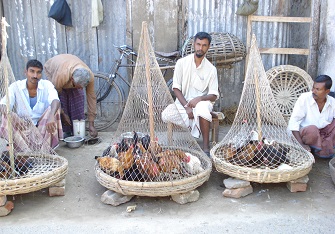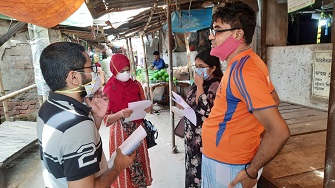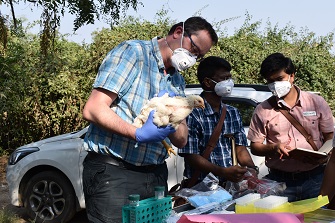
UK Research and Innovation (UKRI) Global Challenges Research Fund (GCRF) One Health Poultry Hub
The RVC-led UKRI GCRF One Health Poultry Hub brings together leading laboratory, clinical, veterinary and social scientists, as well as skilled communications experts, programme support staff and external stakeholders.

Challenge
Chicken is globally the most popular livestock protein source for humans. Production has outpaced that of other land-based animals, doubling since 2000, with >1 trillion eggs and >100 million tonnes of meat consumed annually.
In our study sites (in Bangladesh, India, Sri Lanka and Vietnam) poultry farmers aim to produce affordable protein for their families and for local, national and regional markets. However, rapid expansion and intensification of production, especially with high stocking densities, fast turnover, poor biosecurity, misuse of antimicrobials, complex transport and trading networks, and predominance of live bird markets, are all of concern when it comes to zoonotic diseases.
Much organised chicken production and marketing happens in densely populated areas and as well as contributing to pollution and spread of antimicrobial resistance (AMR), these situations make it easier for disease outbreaks to emerge and spread from locally circulating pathogens, including outbreaks of potentially epidemic or pandemic avian influenza and high incidences of bacterial food-poisoning (e.g., Campylobacter, Salmonella, E. coli).
Our research is guided by a One Health approach which recognises the interconnectedness between the health of people, animals and ecosystems and works across multiple sectors, disciplines and communities to foster well-being, tackle threats and contribute to sustainable development.

Solution
With integrated streams of social, economic, biological, mathematical and policy-led research, we are co-producing detailed knowledge on the biological, structural and socio-economic factors that shape networks of chicken production and distribution most commonly used in Asia. We aim to understand how and why these differentially favour the amplification, diversification and spread of AMR and zoonotic pathogens at the human/poultry interface.
Our interdisciplinary team is mapping and modelling the networks through which chickens and eggs are produced, marketed and consumed, assessing the spatial distribution and flows of chickens and people, analysing the genetic diversity of pathogens and gut flora along networks, and measuring the inputs and residues of antimicrobials.
Downstream analysis is focused on molecular changes that indicate increased host range, changed virulence, or acquisition of AMR. We are using ethnographic, socio-economic and community engagement methodologies to produce knowledge of the social, structural and cultural factors that that influence the behaviours and actions of key actors along the networks and combining these outputs with biological data to generate integrated models of pathogen transmission and disease risk.
Based on the evidence the Hub generates, we will evaluate targeted interventions (technical, behavioural and institutional) designed to reduce zoonotic risk, whilst satisfying the need for countries to increase their production of chicken meat and eggs. We are also undertaking policy analysis as we seek pragmatic, adaptable and innovative interventions that consider the technical, behavioural and regulatory contexts.

Impact
The direct end users of our research include all those along the poultry production and distribution networks in Bangladesh, India, Sri Lanka and Vietnam. These range from producers and breeders of chickens and eggs to those consuming chicken meat and chicken products, and takes in the very many local, national, regional and international actors whose decisions and policies influence and regulate poultry production and trading. Evidence we are generating on the specific factors that influence zoonotic transmission is also crucial for stakeholders in other countries where livestock intensification, or incursion from zoonotic diseases, presents growing public health risks.
To ensure lasting and positive impact from the Hub’s work, we undertake a range communications, engagement and capacity-building processes, activities and outputs to interact with and influence stakeholders. We are brokering, establishing and maintaining cross-sectoral partnerships between scientists, government ministries, international agencies and the commercial poultry sector in Asia and the UK, creating opportunities for sharing data and experience, and building common understandings for collaboration, as well as common approaches to evidence-led regulation in the poultry sector and to integration of poultry health into national health systems.
Partners
The GCRF One Health Poultry Hub is funded by UK Research and Innovation (UKRI) through the Global Challenges Research Fund (GCRF), which is a key component in delivering the UK aid strategy and puts UK-led research at the heart of efforts to tackle the UN’s Sustainable Development Goals. Our network comprises 27 institutions in 10 countries; more details can be found here.
